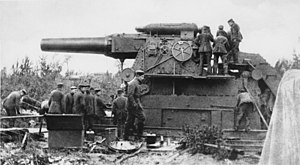Tags
“By late afternoon of August 12, one of the German army’s [enormous 420 mm siege guns, 24 feet long, weighing 98 tons, firing a shell a yard long weighing 1,800 pounds at a range of 9 miles and requiring a crew of 200 attendants] had been set up and aimed at Fort Pontisse, at Liège. Its crew, wearing padding over eyes, ears, and mouth, lay flat on their stomachs ready for the firing which was done electrically at a distance of 300 yards. At 6: 30 the first detonation thundered over Liège. The shell rose in an arc 4,000 feet high and took 60 seconds to reach its target . When it hit, a great conical cloud of dust, debris, and smoke rose a thousand feet in the air. Meanwhile the Skoda 305s had also been brought up, and began bombardment of other forts, “walked in” upon their targets by artillery observers stationed in church towers and balloons. Men of the Belgian garrisons heard the shells descending with a screaming whistle, felt the detonations coming each time more nearly overhead as the aiming was corrected until, as their terror mounted, the shells exploded upon them with a deafening crash and the solid steel heads smashed through the concrete. Over and over the shells came, blowing men to bits, choking them with fumes released by the charge of high explosives. Ceilings fell in, galleries were blocked, fire, gas, and noise filled the underground chambers; men became “hysterical, even mad in the awful apprehension of the next shot.”
Barbara Tuchman, The Guns of August: The Outbreak of World War I

